A False Memory: Nominating the “Nanjing Massacre” to the UNESCO Memory of the World Programme
In 2014, China nominated the “Nanjing Massacre” and the “Comfort Women” to be registered at the United Nations Educational, Scientific, and Cultural Organization (UNESCO) Memory of the World (MoW) Programme.
The biannual registration process will culminate in a decision by the UNESCO International Advisory Committee (IAC), in mid- to late-2015, on which nominations should be registered at the MoW.
While claiming that its intention is the preservation of history, the nomination form submitted by China is filled with pejorative terms and emotive language designed to foster hate against Japan.
There is ample evidence showing that neither the Nanjing Massacre nor the Comfort Women are accurate descriptions of what transpired during the war. However, there continue to be nations that attempt to gain political and diplomatic leverage against Japan by disseminating these falsehoods.
Spreading hate through falsehoods goes against not only the founding principles of UNESCO, it is also an affront to the study and preservation of history that humanity shares. China’s nomination of both historical issues should undergo a rigorous review for its accuracy and its legitimacy.
The Happiness Realization Party, together with Japanese scholars who have conducted extensive research on both issues, have repeatedly pointed out how both the “Nanjing Massacre” and the “Comfort Women” are flawed historical narratives, and have submitted a rebuttal to China’s nomination to the UNESCO MoW.
Below shows the documents that have been submitted to UNESCO (also downloadable as PDF).
The Fabricated History of the Nanjing Massacre
by The Happiness Realization Party
The Happiness Realization Party is a political party founded in May 2009 by the Founder and CEO of the Happy Science Group, Ryuho Okawa to offer concrete and proactive policies to strengthen Japan’s national security and to foster economic growth. It is calling for the denial of the registration of the “Nanjing Massacre” to the UNESCO Memory of the World Programme.
China submitted the “Nanjing Massacre” for its 2014-2015 nomination to the UNESCO Memory of the World Programme. The Happiness Realization Party (HRP) has repeatedly expressed its opposition to this registration, and has collected signatures from citizens who support its view. The HRP created rebuttals for the materials China has presented. This document is a report of the HRP’s rebuttal of both the materials China has provided and the narrative of the Nanjing Massacre itself.
The aggressors are unknown in the photos showing atrocities by the Japanese military
First, there are 16 photographs said to show the atrocities that Japanese soldiers committed when Nanjing fell.
Luo Jin, an employee of the Jinling Photography Studio in Nanjing, is believed to have taken these photos from negatives that he developed after a Japanese soldier dropped them off for processing. The photos became publicly available as follows.
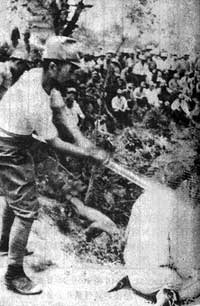
One of 16 photos that allegedly show a Japanese soldier beheading a Chinese man. However, Professor Higashinakano has pointed out, “This is a Chinese fabrication.” While the Nanjing Massacre allegedly happened during the winter, the Japanese soldiers are lightly dressed, and some even have their sleeves rolled up. The shoes of the man in front of the picture aren’t military attire either.
One day, between 1937 and 1939, a Japanese soldier requested to develop two rolls of film. While Luo was working on them, he came to believe that these photos were definitive proof of a massacre by Japanese soldiers, and printed them off under the sun, developing a set for his own use in the process. He took some of those photos and stored them. However, around 1941, he threw them away, feeling that possessing them would put him danger.
In the spring of that year, his friend Wu Xuan found them on the ground in a shed, and decided to keep them. Wu then submitted these photos to the Nanjing War Crimes Tribunal, which the Republic of China established to hold Japanese soldiers accountable for their wartime operations.
However, there is absolutely no proof as to whom, when, and where these photos were taken. The lack of such context means that they should not be used as evidence of Japanese military atrocities.
Those in the photos, who are said to be Japanese soldiers, wore extremely light clothing, which look nothing like the clothing that would have been worn in Nanjing during the winter period (December to February) in which the Nanjing Massacre is alleged to have taken place, when the average temperatures would have been between 3 and 5 degrees celcius. Shudo Higashinakano, a professor of intellectual history at Asia University has analyzed these photos and has concluded that they were taken between late May and early June.
Luo testified that he developed these photos from two rolls of film he received from a Japanese soldier, but the technology of the time meant that he could only develop one size of photograph from a single roll of film. Since there were two rolls of film, Luo then could only develop two photo sizes. However, the 16 photos show at least 5 different sizes, if not more. The logical conclusion would be that the unrelated photos were added in order to submit to the Nanjing Tribunal.
Thus, when one compares the route by which Luo developed these photos and his testimony, it is highly likely that the pictures had no connection to the Battle of Nanjing. These photos do not allow one to say that the Nanjing Massacre happened. On the contrary, the fact that these irrelevant photos needed to be collected suggests that it never took place.
[1] See the film, “Nanjing 1937”, a joint production between China, Hong Kong, and Taiwan, for example.
The Magee Film does not show a single image of atrocities by the Japanese military

This picture allegedly shows “thousands of civilians bound with ropes and killed using machine guns, machetes, and grenades. However, although it is difficult to see, the civilians had arm-bands with a Japanese flag on them. This suggests that the Japanese military was attempting to separate the Chinese soldiers from civilians.
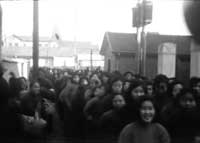
The bottom picture shows a woman in front smiling toward the camera.
The second item is a film, known as the “Magee Film.” John Magee, a priest and a member of the International Committee for the Nanking Safety Zone, is believed to have recorded the city under Japanese occupation using a 16 mm film camera. The captured images are of injured people and hospital officials tending to them, which the English subtitles explain as “caused by the Japanese Army”.
The film was passed onto individuals such as Georg Rosen, Secretary to the German Legation in Nanjing, and to the American missionary George Fitch. Fitch, in turn, took the film to American government offices and newspapers, claiming that it showed proof of atrocities by the Japanese military.
The Magee Film, the only film which allows us to see the extent of the Nanjing Massacre, has critical flaws.
There are absolutely no scenes of Japanese soldiers committing atrocities. The only signs of Japanese military barbarism are in the subtitles which were added later. At the time, Chinese Nationalist soldiers were involved in various acts of looting, murder, and rape, making it possible that the victims were a result of such acts.
However, the scene which is explained by the subtitle “Group of female refugees moving to another camp for safety”, shows women with smiles on their faces, and is not what one might expect of women under duress or worried about being physically harmed. This film uses images that contain no context, and which are disconnected from the Japanese military in order to create a negative impression through the use of subtitles. At the very least, it is not objective proof of a “massacre”.
Magee, the cameraman himself, was of questionable standing as well.
After the war, he took the witness stand at the International Military Tribunal for the Far East (the Tokyo Trials), testifying that Japanese soldiers had committed many acts of rape and murder.
However, when the Japanese defense counsel asked how many murders he had witnessed first-hand, Magee replied, “Just one.” Moreover, that one person was executed as someone believed to an illegal combatant (guerilla) shaking off the restraints that a Japanese soldier had put on him. International law permitted the execution of such individuals.
In terms of rape, Magee said that he only witnessed two acts, of which one was merely him witnessing a Japanese soldier and a Chinese woman together.
Interestingly, Magee did not present the film in question as evidence at the Tokyo Trials, suggesting that the prosecution knew that it would not hold up in a court of law.
[2]Shudo. Higashinakano, Susumu Kobayashi, Shinjiro Fukunaga, Nankin Jikken “Shōko Shashin” wo Kenshō suru, Sōshisha.
Tsen Shui-Fang’s diaries recording the massacre includes no first-hand accounts of Japanese military atrocities
The third item is the diary, found in December 2001, of Tsen Shui-Fang, who was 62 years old at the time.
The application China put together says that Tsen’s diary is an important material to remember the Nanjing Massacre.
At the fall of Nanjing, she was working as a dormitory director for the Jinling Women’s College of Arts and Sciences. She was in charge of protecting refugees, working as an assistant to Minnie Vautrin, who was on the International Committee of the Red Cross in Nanjing. During this period, Tsen is believed to have recorded Japanese military atrocities and rapes.
However, Tsen’s diary is full of hearsay, such as “from what I hear” and “it appears that,” and lacks first-hand accounts of the atrocities. In the one instance where she witnessed sexual violence, it is not clear as to whether the perpetrators were really Japanese soldiers.
Furthermore, if one were to assume that more than 20,000 rapes occurred, as China claims, there should have been a noticeable increase in the birth rate around October of the following year, when the rape victims would have given birth. However, Kenichi Ara, a researcher of modern and contemporary history, pointed out, “According to birth records from Nanjing, there was no rise in births in October 1938, or abortions in the preceding months.”
In addition, Ara acknowledged, “At the time, missionaries in the Safety Zone, in order to gain support from their home countries, were forced to exaggerate the barbarity of the Japanese Army. Vautrin’s diary records have a large gap in regards to the damages reported to the Japanese Embassy. It is clear that the descriptions in the diary have been exaggerated.” It is possible that Tsen herself was exaggerating the atrocities committed by the Japanese military in order to continue to receive foreign aid. The fact that her diary is short on accounts of rescuing refugees suggests that the diary was meant as a report to foreign contacts, designed to vilify Japan.
Moreover, the diary notes that “the Japanese Army entered the Safety Zone, where they took away and committed atrocities on citizens”. However, the Nanjing Safety Zone was not one where, as in Shanghai, a neutral army existed. In fact, some of the Nationalist soldiers, who had refused to surrender, and had already removed their uniforms, fled to the Safety Zone where they continued to resist. It was proper for the Japanese Army during a time of war to search for them, but this event has been manipulated in the media to create the misinterpretation that there were “atrocities committed against civilians”. The act of harboring combatants goes against the stated purpose and the professed neutrality of the Safety Zone, and is a violation of international law.
In the end, Tsen’s diary is not a record of atrocities she personally witnessed, and it relies on testimonial information. It is also worth noting that diaries that contain no independent verification or research lacks the credibility to be considered evidence.
The aim of China to use Tsen’s diary as a sort of Chinese “Anne Frank’s Diary”, to paint an impression of equivalence between the Japanese and the Nazis in international society, is quite clear.
[3] The Hague Convention protected combatants who wore military uniforms. They had the status of prisoners of war, but killing combatants who had thrown away their uniforms and disguised themselves as civilians was not a crime under international law. During the 2003 Iraq War, the U.S. Army carried out a mop-up strategy, similar to the Japanese Army’s strategy in Nanjing, but it was not called a massacre.
[4] Tsen and the missionaries, who were anti-Japan, pro-China, may have recorded events without checking the perpetrators, creating reports on these events as if the Japanese Army were guilty of them.
[5] John Rabe, the Chairman of the Safety Zone, sold large amounts of weapons to the Nationalist Party Army as the Chinese branch chairman of the Nazi Party.
The forced confessions of Japanese soldiers in captivity cannot be trusted as evidence
As a final point, testimonies exist from Japanese soldiers such as Hisao Ota and Hiroyuki Nagatomi who are said to have been involved with the Nanjing Massacre.
According to sources such as China’s Xinhua News Agency, on December 15th, 1937, the period when the massacre is said to have occurred, Ota stated that he witnessed the Japanese Army disposing of 150,000 corpses.
But did he provide a reliable testimony?
After Japan’s defeat, Japanese soldiers, who had been under prolonged incarceration in China, were brainwashed to acquiesce to communist ideology, and were implanted with views such as “Japan is imperialist”. They were forced to write confessions.
Lieutenant General Shigeru Fujita, who served time at Fushun War Criminals Management Center, confessed, “Finally, with regard to Hirohito, who should be tried as a war criminal for such crimes, I must declare my sincere hatred.” Chinese correction officers coerced these individuals into making confessions until China’s governmental officials forgave them, and these are the testimonials that the Chinese have offered UNESCO as evidence of wrongdoing in Nanjing.

This is a portion of Ota’s testimony.
Lieutenant General Hiraku Suzuki, who was forced into confessing the killing of the heads of the Chinese Communist Party with poison gas, said the following after returning to Japan in 1979.
“The residents went on about things that never happened. If they said, ‘The Suzuki battalion entered from this direction,’ and I said ‘I never stationed my troops there,’ a party leader would counter my claim with ‘what the residents said was correct.'”
The Japanese soldiers were not able to leave prison until either China had brainwashed them, or they admitted to violence and atrocities; it did not matter if the confessions were lies. Testimonies, created under such circumstances, have no reliability.
The same applies to Ota’s testimony. He stated that he saw the disposal of 150,000 bodies on December 15th. However, in the diary of Sergeant Takeo Kajiya, who served under him, he noted that Ota was assigned there on the 25th. In other words, Ota was not even in Nanjing on the 15th, which clearly contradicts the testimony he offered for his release from custody.
Testimonies created through force after the war show that the Nanjing Massacre itself is political propaganda.
No Verifiable Evidence of the Nanjing Massacre
China supplied UNESCO with materials full of contradictions and lies. Therefore, the HRP has provided the following four items to show that there never was any massacre in Nanjing.
(1) The Chinese Nationalist Party created fictitious accusations for the global community to examine
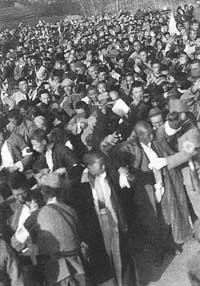
Japanese troops separated civilians from enemy soldiers. Japanese soldiers performed checks to differentiate between Chinese soldiers and civilians. If the Japanese military had engaged in a massacre, then there would not have been a need to perform any checks. Prisoners, who didn’t resist, worked to revive the city of Nanjing.
At the time, the first publication to touch on the “barbaric actions by Japanese soldiers in Nanjing” was a book published by the journalist Harold Timperley of the Manchester Guardian in London in July of 1938.
However, after the war, it was made clear that he was a consultant to the Central Information Bureau of the Chinese Nationalist Party, and a spy who had received funds from the Party. In other words, the Nationalist Party bought foreign journalists to create stories about the Japanese Army’s barbarism. It is clear, even from looking at the facts, which the governments and media of each country wanted to examine, that this was propaganda.
In addition, at the time when the incident is alleged to have taken place, the biggest news story, reported in major papers such as the New York Times, was the “Allison Incident”, which was when a Japanese soldier stopped John Allison, the consul at the American embassy in Nanjing, from entering an area that the Japanese Army was investigating without its permission. A Japanese soldier struck him in the face.
Masanori Mizuma, a researcher of modern and contemporary history, observed, “Western papers at the time spent several days reporting on the Allison Incident, which conversely means that there was nothing more major than a slapping to report.”
[6] Yama Murasaki ni Mizu Kiyoki, Bulletin of the Sendai Army Military Preparatory School which provides Evidence that the Nanjing Massacre never happened.
[7] Harold Timperley, What War Means: The Japanese Terror in China (Japanese translation)
(2) Chang Kai-shek made no mention of the Nanjing Massacre
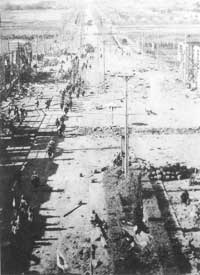
The city streets of Nanjing had no corpses. Major Ohno’s battalion took this picture of one of the main roads in Nanjing on December 13th. Those who advocate the “massacre” narrative claim that the “streets were full of dead bodies”; but the picture clearly shows that it was not the case.
Chang Kai-shek of the Nationalist Party, who was fighting Japan at the time, also held around 300 press conferences for foreign journalists, but never once touched upon any massacre in Nanjing, which proves that the “massacre” narrative was created at a later date.
(3) The Chinese records of the disposals of bodies are fake
The fact that the Nanjing Massacre is a fabrication can clearly be seen in the records of groups such as the Chongshangtang, which supposedly buried the bodies.
At the Tokyo Trials following the war, Chongshangtang stated that it had processed some 110,000 bodies over a four-month period from the start of the massacre. However, documents from that era show that the organization only started its full-time activities eight months after the incident.
Civilians in Nanjing welcomed the Japanese troops
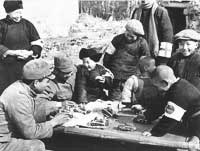
As can be see from this December 20th photo, taken on one of the corners of a main street, Japanese soldiers were playing with local children with toys. This was a mere one week from the fall of Nanjing. (An embedded photographer, Hayashi, captured this moment, and published it in “Asahigraph” on 1/19/1938)
Japanese troops provided medical care to enemy soldiers

Japanese medics created a field hospital on the outskirts of Nanjing, and tended to the injured Chinese troops. If a massacre had taken place, there wouldn’t have been a need to perform any medical treatments. (Photo from December 20th, the work of Hayashi, an embedded photographer. Published in the “China Incident” on 1/27/1938)
In addition, other records clearly state in the “Activities” column of the group that it was a charitable organization which was involved in assisting widows and taking care of children, and that its members did not actually provide burial services. This suggests that the Chinese forged the figure of 110,000 bodies afterwards in order to show that there was a massacre.
During the Tokyo Trials, these forged documents were used in succession as proof of a massacre, without allowing any rebuttal from Japan. There are many issues with the Tokyo Trials, such as the near total lack of neutral judges and the lack of anyone being called into question for perjury.
(4) Nanjing’s population began to increase
As a final point, China submitted application materials that state that the population of Nanjing was originally one million, and that it had dropped to less than ½ after the massacre.
It is true that the population of Nanjing was a million in the summer of 1936. Period documents show that, as many Nanjing residents had evacuated the city in order to avoid war, the population dropped to between 120,000 and 200,000 by the time the Japanese military had arrived, and most of those who remained had sought refuge in the Safety Zone. With the entry of the Japanese military and the restoration of public safety in Nanjing, some of the refugees began to return, and the population of the city recovered to 250,000 a month after the fall of Nanjing.
If there had really been a massacre, then it would have been unnatural for the population to increase beyond its previous level. The Chinese materials resort to using the rapidly decreased population due to the evacuation as evidence of a massacre, which is a disingenuous attempt at manipulation.
The fact that there never was a massacre in Nanjing has been demonstrated academically from a range of research.
The Happiness Realization Party strongly protests the contents of China’s submission to UNESCO, which the Chinese government created for political reasons, and seeks UNESCO’s rigorous review of the nominated materials.



















